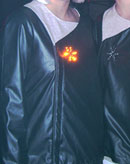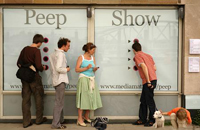:: Wednesday, May 18, 2005 ::
ART AND MOBILE TECH::REVIEWS
loveJACKETS and FLICKR PEEP SHOW
BY::Mark R Hancock
Our wireless, networked world of alone-yet-together in the Ethernet, begs many different questions about what this new way of being means. How will businesses create new ways of generating revenue? How will media companies sell their output to us? What will be the future of print media?
All valid, and as yet unanswered questions, as artists engage with the conditions brought about by the recent mobile technologies and produce works which explore these avenues of thought and others in the wireless environment. Some are creating frameworks within artistic practise that allow for a questioning of the new relationships we have between ourselves and the network - given the move away from fixed locations and the mindsets that they root us within. But, my question is: are artists asking the right questions? By taking a brief look at two projects, we can begin to define what the right question might look like. TheloveJackets(1995) ask what it means to move about within a public space and to be looking for the one person whom we might connect with. The idea that we will look for a familiar face in a crowd is taken into the digital with the production of two jackets that respond electronically when in close proximity to each other. A patterned display of LEDs on the lapels and a sound like -a crickets mating call- is activated when the infrared sensors find a match. TheloveJackets work well and could be augmented to provide expanded versions that go much further.
TheloveJackets(1995) ask what it means to move about within a public space and to be looking for the one person whom we might connect with. The idea that we will look for a familiar face in a crowd is taken into the digital with the production of two jackets that respond electronically when in close proximity to each other. A patterned display of LEDs on the lapels and a sound like -a crickets mating call- is activated when the infrared sensors find a match. TheloveJackets work well and could be augmented to provide expanded versions that go much further.
In itself, the project reminds us that wireless and locative, don't always mean beyond our line of sight or located in an obscure location, but might simply be used to guide us in finding a common minded individual within a crowd. What theloveJackets project also does is use very simple technology to prove a point; showing that it isn't always the so-called high tech projects that have that capacity. Another project that addresses the idea of location and relationship, is the Flickr Peep Show hosted by Mediamatic. Flickr is the free-to-use Moblogging site that uses a series of tags to allow people to upload and organize their images. Tagging allows different themes of images to be grouped by selecting the categories.
Another project that addresses the idea of location and relationship, is the Flickr Peep Show hosted by Mediamatic. Flickr is the free-to-use Moblogging site that uses a series of tags to allow people to upload and organize their images. Tagging allows different themes of images to be grouped by selecting the categories.
For this exhibition, the viewing takes place through small gaps in paper placed on the display windows of the exhibition space. Viewers can choose to see
different images hosted on the servers, by texting the tag keywords.
Flickr Peep Show reduces the value of the web based image, to a solid, -gallery space- type of exhibition, which begs the question, is it net art or gallery art? Beyond arguing the semantics of this question, we are drawn to consider how mobile tools free us from the space we are in, and allows for the sense of location to move into a different realm. Space (of the image) moves to space of the server, which in turn becomes the space of the viewer and gallery. Beyond merely being a different form of photographic exhibition, Peep Show allows for arrangement via the texting, which reflects the web based origins of the images.
Unlike the -simple- technology of the loveJackets, Peep Show needs it's technology to exist. But it, otherwise, does very little new in terms of groundbreaking technology(at least to the outsider), and merely asks for consideration of the everyday tools we are already making use of. As we think more about where we really -need- to be, Peep Show tells us that actually, on the trivial level, we are already moving through space and occupying different places to our friends, yet the social bonds continue to exist, perhaps more augmented than ever before.
If the loveJackets are about finding our -ideal partner- in a crowd, Peep Show is also about how we might never lose our selves, assuming we have connectivity that is. It also makes us realize that nothing on the Internet is private. All data and revelation is available to everybody, even if they don't have an Internet connection or are just passing the street where the exhibition is being held.
Of course, my original question in the opening paragraphs of this article was somewhat disingenuous. I don't truly believe that there is a -right- question to ask about the wireless issues surrounding media arts practise. Just as there isn't any right question to ask about any art form. But what I wanted to consider was how the questions are being formulated, and to show that the technology isn't inherently the question itself, but merely a mirror for showing us something of our everyday lives. Even if that technology closely resembles the facts of daily life itself, there still has to be room for consideration and art, as has always been the case, allows us room for that.
::
The loveJackets will be part of the 'Pattern Language-Clothing as Communicator' show, organized by the Tufts University Art Gallery, curated by Judith Fox, and Traveling Summer 2005-Winter 2008.